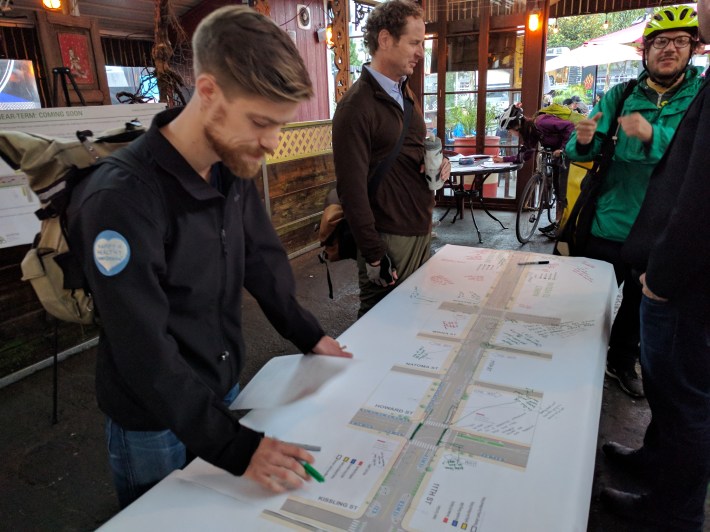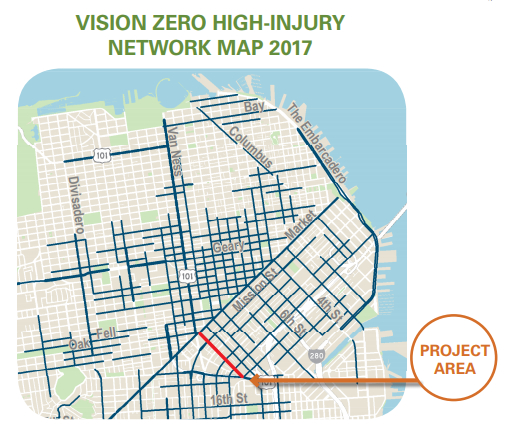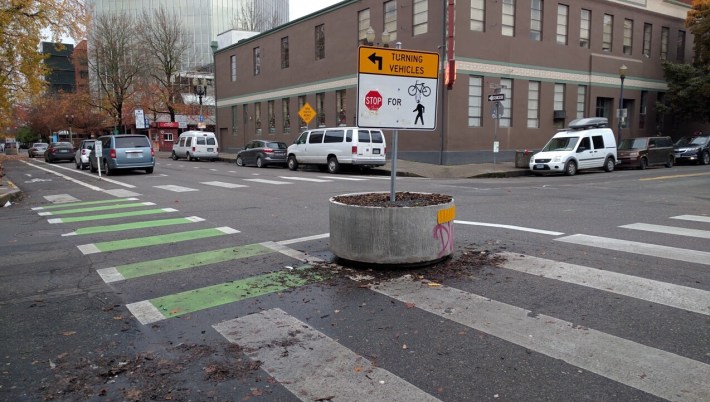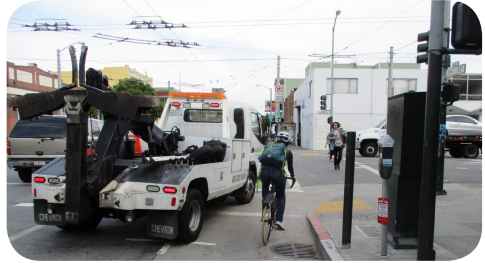The SFMTA held an openhouse last night to get feedback on initial designs for bike and pedestrian safety improvements on 11th Street, which runs from Market to Division. Some 20 members of the public, most of them cyclists who commute through the area, showed up to see design boards and talk to SFMTA officials at the SoMa StrEat Food Park on 11th, across from the Costco warehouse.
Almost right away, some of the visitors found a major deficiency with the drawings: the intersections. "Why the horrible mixing zones?" said Kyle Grochmal, a cycling advocate who rides through the area frequently on his way from the Mission to downtown. "The route's only as good as its weakest link." He also called out the fact that the bike lanes stopped at every intersection.

Elias Zamaria, another cyclist at the meeting, agreed, writing on his comment card that SFMTA should at least "... stripe bike lanes through intersections." Even SFMTA's own materials note that the serious collisions and fatalities happen primarily at SoMa's major intersections.

SFMTA officials seemed unsure as to why, at least in the current drawings, there was no bike lane paint or markings across major intersections (there were some two-stage turn bike boxes and markings at alleys). Jamie Parks, Livable Streets Section Leader at the SFMTA, said there were concerns about making intersections too cluttered and confused. He also said the hope is in the longer term to install more, albeit expensive, signalized and protected intersections--something along the lines of the protected intersection that was put in at nearby Division and 9th. That intersection treatment costs $350,000 and, no doubt, would be even more expensive for the intersections on 11th, since they would require phased bike traffic signals.
However, it remained unclear as to why some cheaper, temporary alternatives couldn't be worked out. For example, in the picture below from Portland, OR, a large circular planter is placed a few feet from the corner of an intersection to force turning cars to slow significantly before crossing into the bike and pedestrian space. Portland, and other cities, also continue the bike lane markings across the intersection box.

"Protected intersections on longer-term projects like Folsom, Howard and Market streets should be considered at every intersection with sufficient space to accommodate them. For the short-term project on 11th Street, it's important to see the protected bike lanes and other planned safety improvements move forward promptly," wrote Chris Cassidy, spokesman for the San Francisco Bicycle Coalition, in an email to Streetsblog.
Meanwhile, Jeremy Battis was concerned about keeping the bike lanes consistent. In the drawings presented by SFMTA, the parking protected bike lane changed to a conventional unprotected bike lane on the stretch between Harrison and Folsom, the argument being there was too much need for loading space for cars and trucks. One attendee suggested setting up a center loading lane for trucks on 11th. Battis also had some doubts about protected bike lanes, if they're not wide enough. "The fatal flaw here is there often is not enough room to pass another cyclist."
Nati Ramirez, a frequent bus riders, wants SFMTA to fix the bus loading areas where 11th meets Market. "It's very congested. When school begins, the 9R and 9 buses ... they have no way to discharge with so many pedestrians around," she said.
The 11th Street open house, meanwhile, is part of a series of projects and outreach efforts by SFMTA to improve safety in SoMa. SFMTA recently added protected bike lanes on 13th, 7th, and 8th. There's also protected bike lanes in the works for Folsom and Howard. Let's hope that at the next open house, SFMTA will also add some robust intersection safety treatments to the drawings--and, someday, to the streets themselves.

Take SFMTA's survey on the 11th Street project. And leave your comments below.





